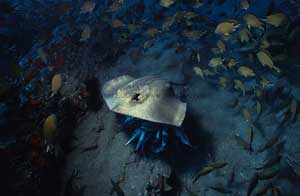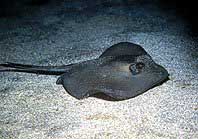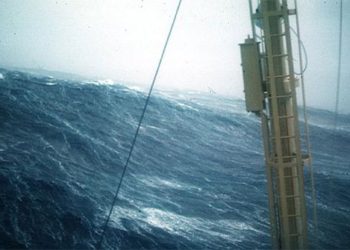The venomous stingray (scientific name: Dasyatis violacea) is the most dynamic creature in the family of stingrays. They are easily recognizable when this special fish moves:  They often “fly” through the water with their fins moving like wings, or swim quickly near the ocean floor with a wave-like motion of their fins. At those moments, they appear as graceful spaceships gliding through the depths of the ocean.
They often “fly” through the water with their fins moving like wings, or swim quickly near the ocean floor with a wave-like motion of their fins. At those moments, they appear as graceful spaceships gliding through the depths of the ocean.
Another notable feature of this “underwater spaceship” is that when they “land” on the sea floor, the venomous stingray knows how to flap sand over its body to… camouflage.
Physical characteristics: Their bodies are flat and resemble a triangle. They have a round snout, and their eyes are positioned on the top of their head. An adult male measures about 0.8 meters in length and weighs approximately 20 kg.
The primary diet of the Dasyatis violacea consists of mollusks and small fish.
They are called “venomous stingrays” because nature has equipped them with a powerful weapon – venomous spines – to compensate for their seemingly gentle and fragile appearance, which makes them vulnerable. These dangerous spines are like poisoned daggers that can inflict serious wounds and even pose a threat to human life. In some areas, these venomous spines are attached to the heads of weapons.
 The tail of the stingray resembles a whip. It is nearly three times the length of its body. The tail has two spines with jagged edges like saw teeth, connected to venom glands. Venomous stingrays skillfully maneuver their tails to stab these “fearsome daggers” into their enemies.
The tail of the stingray resembles a whip. It is nearly three times the length of its body. The tail has two spines with jagged edges like saw teeth, connected to venom glands. Venomous stingrays skillfully maneuver their tails to stab these “fearsome daggers” into their enemies.
The reproductive habits of this “dangerous” fish are also quite unique: Instead of laying eggs in the water like other fish, female Dasyatis violacea retain an egg inside their bodies. Inside the mother’s belly, the egg develops until it is ready to hatch. At that point, the pregnant stingray gives birth to a young stingray that looks like a miniature version of an adult venomous stingray.
The Dasyatis violacea wanders through tropical and subtropical seas.





















































